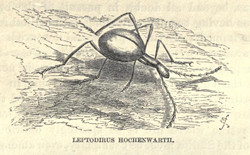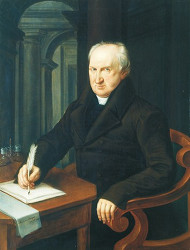Leptodirus hochenwartii
Cave Beetle - Slenderneck Beetle



This is the cave beetle. It was first found in 1831 by Luka Čeč, cave guide and lamp man at the Postojna Cave in Slovenia. He was cave explorer and made numerous important discoveries in Postojna Cave. In 1818, he discovered the entrance to the inner parts of the huge cave system, until then only the first 100 m had been known. Afterwards the local guides started to explore the cave section by section. One day in September 1831 he explored unknown parts of the cave and found a strange bug resembling a big ant, which he collected. He recognized the importance of an unknown cave animal, and gave the specimen to count Franz von Hohenwart who was preparing the first printed guide about Postojna cave at that time.
Franz Josef Hannibal Graf von Hohenwart (*1771-✝1844) was an administrative official and naturalist from Carniola. But he was unable to determine the species and gave it to Ferdinand Jožef Schmidt, a naturalist and entomologist from Ljubljana. Schmidt realized that this bug was an unknown species and that it was a true cave animal. This animal was adapted to the cave environment and not able to live on the surface. He published it in an article named "Beitrag zu Krain’s Fauna" (Contribution to the fauna of Carniola) named it Leptodirus which means "slender-necked". As customary with latin names the second part was the latinised name of the discoverer, hochenwartii. At this time the duke used the form Hochenwart with ch, due to changes in the German language rules, the count later wrote his name as Franz Hohenwart.
But with all the knowledge and resourcefulness they both forgot, that Luka Čeč was the real discoverer.
Literature
- F. J. Schmidt (1832): Beitrag zu Krain’s Fauna, Illyrisches Blatt, 1832 (3): 9-10.
- Slavko Polak (2009): Importance of discovery of the first cave beetle Leptodirus hochenwartii Schmidt, 1832, ENDINS, núm. 28. 2005. Mallorca. researchgate
 Search DuckDuckGo for "Leptodirus hochenwartii"
Search DuckDuckGo for "Leptodirus hochenwartii" Leptodirus hochenwartii (visited: 23-AUG-2018)
Leptodirus hochenwartii (visited: 23-AUG-2018) Leptodirus hochenwartii F. J. Schmidt (visited: 24-AUG-2021)
Leptodirus hochenwartii F. J. Schmidt (visited: 24-AUG-2021)
 Index
Index Topics
Topics Hierarchical
Hierarchical Countries
Countries Maps
Maps